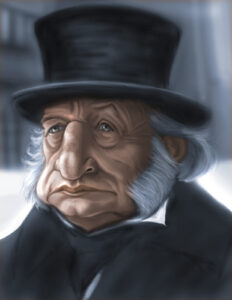If asked to name the biggest fictional Christmas villains, you might pick Scrooge and the Grinch. Scrooge, Dicken’s fascinating character from the 1843 story A Christmas Carol, leaves the bigger footprint, of course. He belongs not just to Christmas: Scrooge can show up year-round in any situation, and we all nail him for what he is!

Yet Dicken’s Scrooge does reform. He renews himself through a redemptive process common to most of us: we look back with understanding and sympathy on the difficulties of youth; we cringe at decisions made in middle adulthood; and we muse worriedly about how our life’s work will appear in whatever sense of Final Judgment we believe is coming. Plus, Dickens tosses us so many inspiring nuggets throughout the story, we have no choice but to become Scrooge’s biggest cheerleader.
Can you feel the same warm fuzzies about the Grinch, though? I have a hard time enjoying this story, although millions of people do. Theodore Seuss Geisel (Dr. Seuss) brought out The Grinch Who Stole Christmas in 1957, a banner year in which he also published The Cat and the Hat. Geisel’s story accounts for our modern usage of “grinch,” generally defined as a spoilsport. There are scattered literary uses of the term “grinching,” as in making a harsh noise (Rudyard Kipling, 1892), and a few unattractive fictional characters appear with the name “Grinch,” but otherwise, Dr. Seuss owns it!
Yet the Grinch, despite his towering popularity, develops little as a character (far less than the Cat in the Hat) and not just because of the story’s brevity. Too much is missing for us to peer into the Grinch’s soul. There are no spirits of Christmas past, present or future. No deceased, tormented business partner springs from the shadows to pummel perspective into the Grinch’s head. Plus, is the world really a better place after the Grinch reverses course, returns the stolen stuff, and sits at the head of the Christmas table to carve the beef?
What does account for the embrace of these two seasonal villains? With Scrooge, of course, the master storyteller Dickens gave us a tremendous plot overflowing with meaningful, unforgettable characters, as he did in all of his writings. A Christmas Carol ends with the casting off of darkness and a re-embrace of all that is good, true, and lovely.

Geisel’s Grinch, though, is another case. The character is helped by the author’s strange, winsome drawings and story also has enjoyed the benefit of film renditions fueled by inimitable voices like Boris Karloff ‘s (1966). Still, is that enough to elevate a green figure to the status of villain-turned-hero in the secular celebration of Christmas?
Perhaps the real power behind both of these literary characters lies in the way they provide uncomplicated models of redemption. Scrooge’s redemption, of course, is a deep one, a timeless and classical one, relatable to all. We understand it because most of us, somewhere in our lives, experience at least one of the three stages of judgement he faces that fateful evening.
The Grinch’s redemption strikes me as hard to swallow, occurring literally at the tipping point of his destruction of the village’s Christmas and their overall well-being. As sweet as I find the reason for his turn-around (his misdeeds cannot quell the joy of singing), can anyone really imagine a whole town waking up to bare living rooms and empty pantries, yet still assembling to unite in song? Not, at least, without a spiritual imperative that is lacking at the story’s core.
Nonetheless, I ought to lighten up on the Grinch, I suppose. People embrace the Grinch because he gives them an easily absorbable sense that the good and meaningful can happen. Some people may have no higher model. Others, inclined to disembody the message of Christ’s purpose, are happy to make the Grinch a palatable substitute.
Christmas has to be confusing if a person has only a secular understanding. I refer not to the beautiful traditions of holiday concerts, gatherings with family, festive meals, and the like. The confusion comes from losing the linkage of Jesus in the cradle to Christ on the Cross, and it is lost on those not versed in the language of Christianity. It is far easier for many to revel in an amorphous “Christmas Spirit” as an agent of change than embrace the Omnipotent God of the Judeo-Christian tradition.
But artists have worked bountifully with this linkage across time. Consider the countless painters who emphasize in their canvases the dual symbolism of the wood of the manager as wood foretelling the Cross, the similarity of swaddling clothes to Christ’s shroud cast aside at His resurrection, and even the rocky surfaces of that very tomb which point back to the cave wherein, according especially to Eastern Christian tradition, Joseph found refuge for Mary.
We are experiencing disturbing times, especially in Western Culture. I needn’t tell any of you, dear readers, just what tumult our world is undergoing. As one example, Christianity has been knocked so far down the scale in terms of its presence in our public life, many Christians find themselves creeping around, hiding their beliefs, values, and convictions. This would not be the first time that the faithful would be in exile in history, but it may be one of the first where the exile is self-imposed, at least for those privileged to live in relatively safe climes like the United States.
It is easier to take on the fictional villains of Christmas than the real ones. While fictional villains provide us with good lessons, Advent is a chance to consider the reality of redemption and to overcome whatever real villains stand between us and the chance to become re-enchanted by the reality of Christ’s birth.



